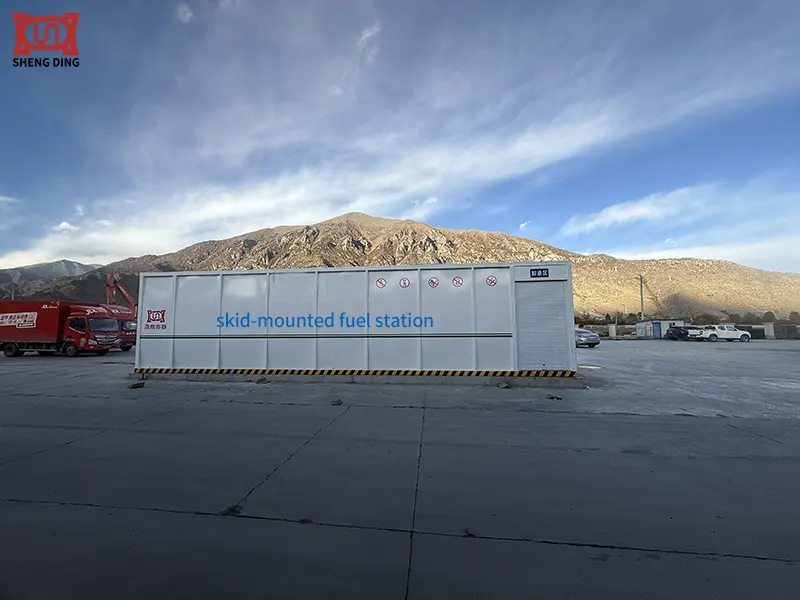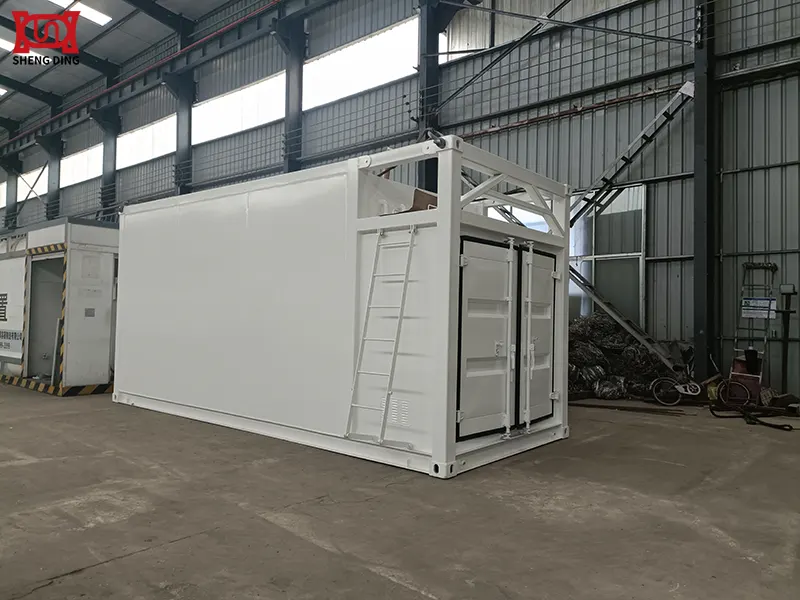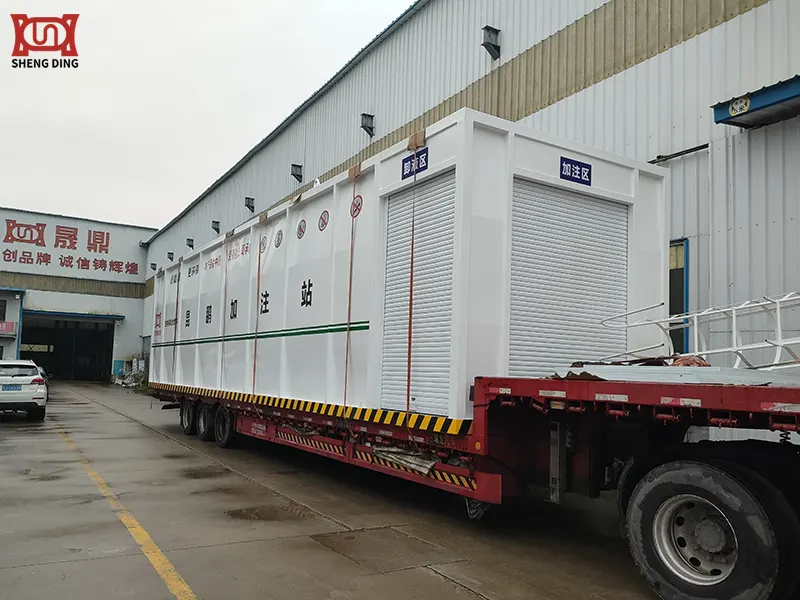Comparison of Costs and Benefits of Installing Skid-Mounted Fuel Stations Within an Enterprise
Skid-mounted gas stations have been popular with fuel-using businesses since their introduction. They significantly improve production efficiency and play an irreplaceable role in saving fuel costs. Furthermore, their high-performance safety systems have made them the top choice for oil storage equipment in the industry. However, while skid-mounted gas stations offer many advantages, their costs are also very high, making them unsuitable for businesses with small fuel consumption. Many companies want to understand the true cost-benefit comparison of skid-mounted fuel station. Today, Shengding Container Manufacturer will provide a detailed explanation of the cost-benefit comparison for installing skid-mounted fuel stations within a company.


1. Cost Analysis (Initial Investment + Operating Costs)
When conducting cost analysis, it's crucial to remember not only to calculate the cost of installing the skid-mounted gas station, but also to include the subsequent operating costs. After all, once the skid-mounted gas station is installed, the job is done. We still need to manage, operate, and perform regular maintenance on it, all of which must be taken into account.
1.1 Initial One-Time Investment
This section covers all costs incurred in the initial stages of site construction, primarily including equipment investment, infrastructure investment, approval fees, and other supporting facilities. A detailed breakdown follows.
Skirt-Mounted Equipment Itself:
- This is the core cost, including storage tanks, fuel dispensers, automatic fire suppression systems, explosion-proof electrical systems, etc. Prices vary depending on capacity (commonly 20-50 cubic meters), brand, and configuration (e.g., single-product/dual-product).
- Estimated Range: US$100,000 - US$700,000.
Land and Civil Engineering Costs:
- Site: Requires a permanent plot of land that meets safety regulations (typically approximately 40-100 square meters).
- Leveling, paving, fencing, drainage ditches, etc.: This cost is easily underestimated.
- Estimated Range: US$20,000 - US$50,000 (depending on the company's existing site conditions).
Approval and Safety Assessment/Environmental Assessment Fees:
- This is the most critical and complex aspect. The initial investment requires applications and approvals from multiple departments, including emergency management, fire protection, environmental protection, and market supervision. A qualified agency must be hired to conduct a safety assessment and environmental impact assessment.
- Estimated range: US$10,000 - US$40,000 (depending on local policies, intermediary service fees, and time costs).
Installation and commissioning costs:
- Includes equipment transportation, hoisting, pipeline connections, and system commissioning.
- Estimated range: US$4,000 - US$10,000.
Other initial costs:
- Lightning protection and grounding engineering, video surveillance system, signage, etc.
- Estimated range: US$6,000 - US$30,000.
Based on the above analysis, we can roughly estimate the total initial investment: Conservative total: approximately 140,000 - 830,000 USD. This is a general range; the specific amount needs to be calculated based on the company's actual situation and local policies.
1.2. Subsequent operating costs
- Fuel procurement costs: This is the largest ongoing cost. The company needs to find compliant refined oil wholesale suppliers (such as Sinopec, PetroChina, and local refineries).
- Personnel Wages: Trainingd full-time or part-time managers, operators, and safety officers are required.
- Equipment Maintenance and Routine Inspections: Regular maintenance and mandatory inspections of equipment, safety facilities, and measuring instruments are necessary.
- Insurance Costs: High-value public liability insurance and other relevant insurance must be purchased to mitigate the risk of safety accidents.
- Safety Management and Training Costs: Continuous fire drills and safety training are required.
- Taxes: If internal settlements are involved, relevant tax treatments may apply.
2. Revenue Analysis
The main benefits are in "cost reduction" and "efficiency improvement," mostly implicit benefits.
2.1. Direct Economic Benefits (Cost Reduction)
Oil Price Difference Benefits:
- This is the most crucial benefit. There is a significant price difference between wholesale and retail prices. Taking diesel as an example, the wholesale price may be 0.8-1.5 yuan per liter cheaper than the retail price, or even more.
- Calculation Formula: Annual Fuel Cost Savings = Annual Fuel Consumption (liters) * Price Difference per Liter
- Example: If a company's fleet consumes 500,000 liters of diesel annually, and saves 1 yuan per liter, the direct annual fuel cost savings would be 500,000 yuan.
Savings in Driver Time and Labor Costs:
- Employees no longer need to spend significant time queuing for refueling, this time can be used for transportation or operations, increasing effective working hours.
- Saved Labor Costs = (Average Time per Refueling * Number of Refuelings per Year ¡Á Average Hourly Wage per Driver)
Reduced Capital Occupancy Costs (Pre-deposited Fuel Cards):
- Many companies need to pre-deposit large amounts of capital into fuel cards. Building a skid-mounted station can reduce this prepayment, freeing up cash flow.
2.2. Indirect Management and Risk-Reward (Efficiency Enhancement)
Improved Management Efficiency:
- Centralized Management: Unified procurement, storage, and distribution of fuel facilitate refined management and cost control.
- Preventing Fraud: Effectively prevents management loopholes such as "fuel theft," false invoicing, and cash-out schemes. The IC card system enables "one card per vehicle," accurately recording refueling data for each vehicle.
- Data Analysis: Fuel consumption data for each vehicle in the fleet can be easily obtained, providing accurate data for vehicle management, driver evaluation, and cost accounting.
Ensuring Operational Efficiency:
- 24-Hour Supply: Not restricted by the operating hours of individual gas stations, especially suitable for companies operating at night or on shifts.
- Convenient Location: Located within the factory premises, refueling is available immediately, greatly improving vehicle dispatching and operational efficiency.
Fuel Quality and Vehicle Protection:
- Fuel purchased in bulk from reputable channels ensures quality, avoiding the risk of engine damage from substandard fuel, extending vehicle life, and reducing maintenance costs.
3. Cost and Benefit Comparison Summary
| Comparison Dimensions | Cost | Benefit |
| Economic Efficiency | High initial investment and ongoing operating costs. | Significant savings from fuel price differences are the main source of return on investment. |
| Management Concerns | Increases internal management complexity, requiring dedicated personnel for safety and operations. | Significantly improves management efficiency, plugs management loopholes, and enables data-driven operations. |
| Operational Concerns | Occupies company land resources, posing safety and environmental liability risks. | Ensures operational continuity, improves vehicle attendance and operational efficiency. |
| Risk Concerns | Requires full responsibility for safety and environmental accidents. | Ensures fuel quality, reducing vehicle malfunction risks. |
4. Key Decision Factors and Recommendations
4.1. Break-Even Point Analysis (Core):
Your annual fuel consumption is the decisive factor. Generally, the higher the annual fuel consumption, the shorter the investment payback period, and the more feasible the project. A simple and quick assessment method:
- Investment Payback Period (Years) = Initial Total Investment / Estimated Annual Fuel Cost Savings
- If the calculated payback period is within 2-4 years, the project usually has high economic value. If it exceeds 5 years, careful consideration is needed.
4.2. Compliance is the lifeline:
- Compliance approval must be prioritized above all else. Do not construct or put into operation any facility before obtaining all legal permits. otherwise, you will face hefty fines, shutdown, and even criminal liability. It is recommended to hire a professional intermediary agency to assist with the process.
4.3. Safety management is the bottom line:
- A strict safety management system and emergency plan must be established and ensured to be effectively implemented. In the event of an accident, all profits will be wiped out, potentially causing devastating damage to the company.
5. Related Questions
5.1 Is the skid-mounted fuel station equipment a one-time purchase? Is there an annual fee?
A: Shengding Container's products are all one-time purchases and do not require annual renewals. Shengding Container provides lifetime free consultation services for its products, and the company offers 24/7 technical support.
5.2 What are the capacities of skid-mounted fuel stations?
A: We can customize and produce standard models ranging from 5,000 liters to 30,000 liters. Specific needs will be determined based on the customer's individual requirements, and Shengding Container will provide the most cost-effective product procurement plan.
5.3 Is it easy to relocate a skid-mounted fuel station?
A: Flexible transport and quick installation are inherent features of skid-mounted fuel stations, so relocation is very convenient and quick.
5.4 Can I purchase used products?
A: Yes, but we do not recommend it, mainly because the quality of used products is difficult to control, as skid-mounted fuel stations have very high safety requirements.


Conclusion:
For companies with a large number of internal vehicles (such as logistics fleets, construction machinery, shuttle buses) and huge annual fuel consumption, installing a skid-mounted fuel station is a strategically valuable investment. It not only brings direct economic returns, but more importantly, it brings a qualitative leap in management level and operational efficiency. However, for small and medium-sized enterprises with low fuel consumption, limited space, or unable to assume primary safety responsibility, careful evaluation is necessary, as the high initial investment and compliance costs may make it uneconomical.
Final Recommendation: Before making a decision, please conduct a detailed, quantitative feasibility study, accurately calculate your usage volume, and consult professional skid-mounted equipment suppliers and approval service agencies to obtain analysis reports and quotations tailored to your company's specific circumstances.
The above is a comparison of the costs and benefits of installing skid-mounted fuel stations within your company, compiled and published by Shengding Containers. We hope this explanation will be helpful for those considering installing skid-mounted fuel stations in the future. Please feel free to contact us if you have any product needs.
Written by
TAIAN SHENGDING METAL CONTAINER MANUFACTURING CO., LTD.
Editor Wang
WhatsApp:+86 152 5486 3111
Email:shengdingtank@126.com
- WhatsApp
- E-MailE-Mail:shengdingtank@126.com
- WeChatWeChat:15254863111









